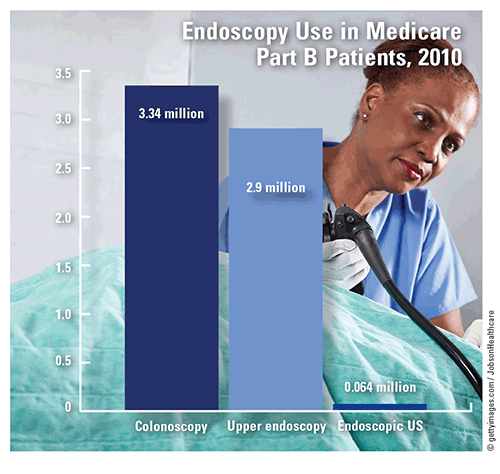US Pharm. 2019:12(44):16.
Each year, according to the National Ambulatory Medical Care Survey, digestive diseases affect 60 million to 70 million people, causing 4.6 million hospitalizations, 72 million ambulatory-care visits, and 236,000 deaths. The 22.4 million physician office visits resulting in a primary diagnosis of digestive disease were made by more men than women (14.4% vs. 12.6%). Colorectal/anal cancer topped the list of causes of every 100,000 deaths due to digestive disease, followed by esophageal cancer, gastric cancer, vascular intestinal disorders, Clostridium difficile colitis, gastrointestinal (GI) hemorrhage, and paralytic ileus/intestinal obstruction.
Outpatient Visits: In 2009, patients with the most visits to outpatient clinics listed abdominal pain (15.9 million) as the reason for their visits, but this diagnosis was confirmed in only 45.3% of cases (7.2 million). Significantly fewer cases were confirmed upon examination for reported cases of nausea and vomiting (1.7 million vs. 6.8 million), diarrhea (2.4 million vs. 4.2 million), and dysphagia (1.1 million vs. 1.2 million). For rectal bleeding/hemorrhoids, constipation, and Barrett esophagus, however, the number of confirmed cases exceeded the number of patient reports (58.8%, 25%, and 3.4 times more, respectively).
Emergency Department (ED) Visits: In 2016, digestive disease was the primary diagnosis in 5.5% (15 million) of ED visits and was the principal diagnosis for 10.5% (1.4 million) of all discharges. The most common reason for visiting the ED was complications of surgical and medical care (1.1 million) for digestive disease, followed by constipation (0.9 million); gastritis and duodenitis (0.5 million); esophagitis without gastroesophageal reflux disease (0.3 million); abdominal-cavity hernias other than diaphragmatic (0.3 million); diverticulosis (0.3 million); anorectal diseases (0.3 million); and intestinal obstruction (0.3 million). Digestive disease ranked fourth among the reasons for 3.4 million pediatric ED visits in 2015.
Inpatient Visits: Patients who were diagnosed at discharge with intestinal adhesions causing obstruction had the longest hospital stays (mean 8.8 days), followed by those who were diagnosed with Clostridium difficile infection (6.9 days), diverticulitis without hemorrhage (5 days), unspecified intestinal obstruction (4.5 days), or nonspecific GI hemorrhage (4.4 days). In 2016, the principal diagnosis for a half-million (15.6%) readmissions was a digestive disease, according to the Agency for Healthcare Research and Quality. Of all adverse drug events during hospital stays, 0.4% were attributed to drugs that were used to treat digestive diseases. Esophageal disorders constituted the third most common co-occurring physical condition in patients admitted for mental-health problems or substance abuse (14.1%). Among inpatients with GI hemorrhage, 14.5% had co-occurring alcohol-related or substance-related disorders. Colonoscopy was the most frequently performed procedure in Medicare patients, followed by upper endoscopy and endoscopic US.
To comment on this article, contact rdavidson@uspharmacist.com.





